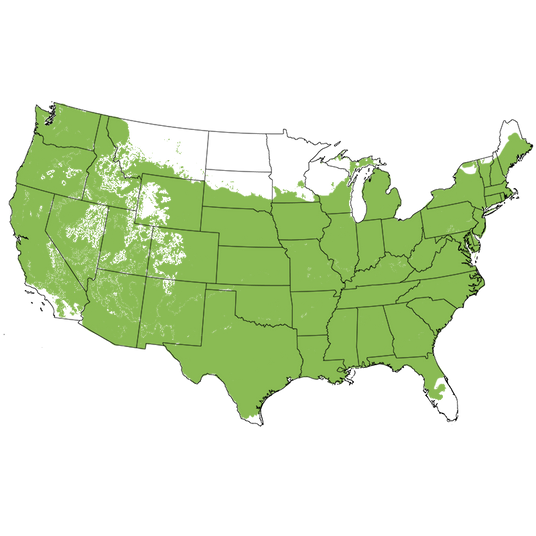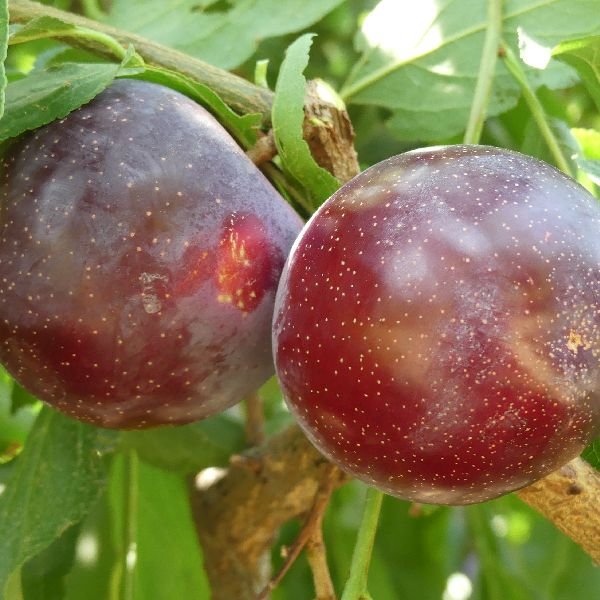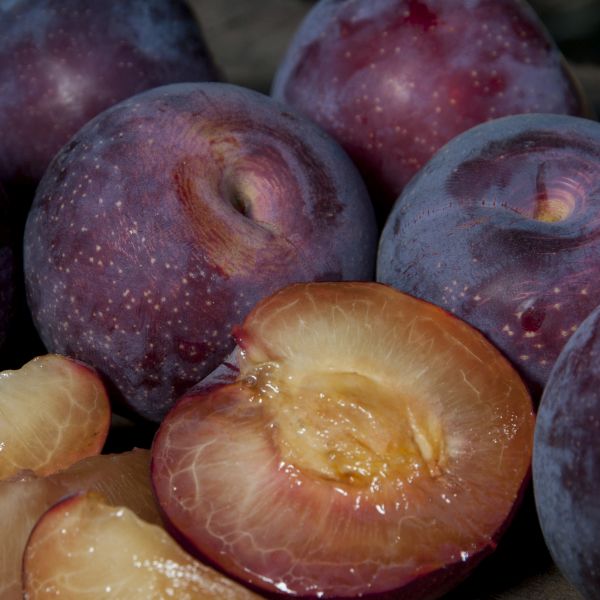Santa Rosa Plum Tree
Prunus salicina 'Santa Rosa'
Plant Sentry™
Plant Sentry™

Plant Sentry™ Protected
Your order is protected by our compliance system that:
- Prevents restricted plants from shipping to your state
- Ensures plants meet your state's agricultural requirements
- Protects gardens from invasive pests and diseases
Delivery and Shipping
Delivery and Shipping
Delivery and Shipping
Fast, Safe Plant Delivery
Ships in 3-4 business days • Tracking provided • Weather protected
| Under $50 | $9.99 |
| $50 - $99.99 | $14.99 |
| $100 - $149.99 | $16.99 |
| $150 - $198.99 | $24.99 |
| $199+ | FREE |
✓ Zone-specific timing • ✓ Professional packaging • ✓ Health guarantee
Understanding Plant Options
Nature Hills offers plants in two main formats:
- Container Plants: Grown in pots with soil, sized by container volume and plant age
- Bare Root Plants: Dormant plants without soil, sized by height measurements
Container Plant Sizes
Container sizes indicate plant age and growing capacity rather than liquid volume equivalents. Our containers follow industry-standard nursery "trade gallon" specifications, which differ from standard liquid gallon measurements.
Young Plants (6 months to 18 months old)
| Container Size | Actual Volume | Metric Equivalent |
|---|---|---|
| 2" x 2" x 3" | 0.18 - 0.21 dry quarts | 0.20 - 0.23 dry liters |
| 4" Container | 0.31 - 0.87 dry quarts | 0.35 - 0.96 dry liters |
| 4.5" Container | 0.65 dry quarts | 0.72 dry liters |
| 6" Container | 1.4 dry quarts | 1.59 dry liters |
| 1 Quart | 1 dry quart | 1.1 dry liters |
| 5.5" Container | 1.89 dry quarts | 2.08 dry liters |
Established Plants (18 months to 2.5 years old)
| Container Size | Actual Volume | Metric Equivalent |
|---|---|---|
| 2 Quart | 2 dry quarts | 2.2 dry liters |
| #1 Container | 2.26 - 3.73 dry quarts | 2.49 - 4.11 dry liters |
| 5" x 5" x 12" | 3.5 - 4.3 dry quarts | 3.85 - 4.74 dry liters |
Mature Plants (2-4 years old)
| Container Size | Actual Volume | Metric Equivalent |
|---|---|---|
| #2 Container | 1.19 - 1.76 dry gallons | 5.24 - 7.75 dry liters |
| #3 Container | 2.15 - 2.76 dry gallons | 8.14 - 12.16 dry liters |
Large Plants (3-5 years old)
| Container Size | Actual Volume | Metric Equivalent |
|---|---|---|
| #5 Container | 2.92 - 4.62 dry gallons | 12.86 - 20.35 dry liters |
| #6 Container | 5.25 - 6.01 dry gallons | 23.12 - 26.42 dry liters |
| #7 Container | 5.98 - 6.53 dry gallons | 26.34 - 28.76 dry liters |
Bare Root Plants
Bare root plants are sold by height from the root system to the top of the plant. Plants may exceed minimum height requirements.
Common Sizes:
- Trees: 1 foot, 2 feet, 3 feet, 4 feet, 5 feet, 6 feet
- Shrubs & Perennials: 1 foot, 18 inches, 2 feet
Important Notes
Container Volume Specifications
- Trade Gallon Standard: Our containers follow industry-standard "trade gallon" specifications established by the American National Standards Institute (ANSI Z60.1) for nursery stock
- Volume Variations: Actual soil volume may vary due to plant root systems and growing medium settlement
- Age Indicators: Container size primarily indicates plant age and maturity rather than liquid volume equivalents
Growing Conditions
- Plant size can vary based on variety and growing conditions
- Container size helps indicate plant maturity and establishment level
- Larger containers generally mean more established root systems and faster landscape establishment
Seasonal Availability
- Bare root plants are available seasonally when dormant
- Container plants are available throughout the growing season
- Specific varieties may have limited availability in certain sizes
Questions?
For questions about specific plant sizes or availability, please contact our plant experts who can help you choose the right size for your landscape needs.

Plant Sentry™ Protected
Your order is protected by our compliance system that:
- Prevents restricted plants from shipping to your state
- Ensures plants meet your state's agricultural requirements
- Protects gardens from invasive pests and diseases
Plant Profile & Growing Essentials
Cold hardy, Self-pollinating, Flowering, Edible, Ornamental Berries/Fruit, Thornless, Attracts pollinators, Disease resistant, and Fast-growing
Specifications
Specifications
-
Botanical Name
-
Height
-
Width
-
Growing Zones
-
Sunlight
-
Growth RateModerate
-
Flower Color
-
Leaf Color
-
NativeYes
-
Pollinator FriendlyYes
-
Pollinator Required
-
FragrantYes
-
Bloom PeriodLate Spring
-
Does Not Ship ToAK, CA, HI, ID, MT, OR
Planting & Care Instructions
Planting & Care Instructions
Heat-Tolerant Gorgeous Juicy Fruit - Santa Rosa Plum Tree!
- Delicious Healthful Fruit
- Gorgeous Red-Hued Purple Skin
- Sweet Amber Yellow Flesh
- Fragrant Pinkish-White Spring Flowers
- Late Mid-Season
- Dependable Harvest Year After Year
- Hardy, Heat-Tolerant
- Self-Fertile
- Healthy Versatile Jewels
- Full Sun!
Treat yourself to in-season Plums in arms reach, when you plant or Santa Rosa Plum Tree (Prunus 'Santa Rosa') in your yard. First introduced right here in the United States by Luther Burbank, in 1906 in Santa Rosa, California!
This variety is a deciduous, fruit-bearing tree that offers a dependable and delicious harvest each year. Plant one where you can readily enjoy its beautiful blossoms and its gorgeous, juicy fruit.
Watch each spring as the Santa Rosa Plum's fabulously fragrant spring blooms, in frilly white flowers with a pink blush, make their way into your landscape. You'll create a visual spectacle that will have the whole neighborhood jealous.
Enjoy the show while you can; by late July or early August, those blossoms will give way to lovely Plums, ripe for the taking. Santa Rosa Japanese Plums are beautiful to behold, with red-hued, purple skin concealing a layer of red blush, then sweet, yellow flesh surrounding the center clingstone pit.
How to Use Santa Rosa Plum Tree
Your Santa Rosa Plum Tree will produce medium-large, slightly firm fruits that are ideal for fresh-eating right off the tree. Slice them for inclusion in a fruit salad, or add them to a fruit snack plate.
These beautiful Plums are also perfect for canning, freezing, cooking, drying, so you can easily preserve some of your bounty for enjoying later on in the year or sharing with others as gifts. Santa Rosa's firm flesh has amazing flavor! It is sweet with a slightly tangy edge, perfect for a wide variety of uses.
Edible landscaping is all the rage, so remember these gorgeous trees serve double duty as both an ornamental flowering tree that just happens to also grow healthful fruit! Plum leaves are lush and also have great fall color. Even the branching is ornate and provides winter interest!
Faster growing and vigorous, these trees are amazingly heat resistant and do great up to USDA growing zones 9, while being cold hardy down to zone 5! A great size for both a front yard accent tree and for easy use in the orchard!
#ProPlantTips For Care
All fruit trees do their best in full sun, at least 6-8 hours of uninterrupted sunlight. This gives you the highest amount of blooms and therefore the most fruit and the best tasting Plums possible.
Needing ample access to moisture, especially during fruit formation, Plums prefer well-drained soils. A generous layer of mulch helps retain soil moisture as well as insulate the root system from heat and chill.
Santa Rosa Plum Tree is a relatively hardy tree, adaptable to a variety of soils and heat tolerant. It's even self-fruitful, so you don't need to have more than one to enjoy a healthy harvest. Santa Rosa only requires about 300-500 chill hours a year to fruit.
However, you will get more fruit production when planted with other Japanese varieties as pollinator partners. Try Methley or Burgundy to amplify your harvest.
Santa Rosa is an old favorite among Plum lovers and still one of the most often grown. A pretty tree, especially during the spring and late summer growing seasons, Santa Rosa a great investment in something that is both useful and beautiful. Order yours today!
Plum Tree Frequently Asked Questions
How long does it take for Santa Rosa Plum Trees to bear fruit?
Nature Hills Nursery sells fruit trees with mature root systems that are already three to four years old, so you’ll enjoy fruit sooner than you would with younger trees! Expect young Plum trees to begin fruiting usually by the 2nd to 4th year after they establish in your landscape.
How big do Santa Rosa Plum trees grow? How fast do Plum trees grow?
The Santa Rosa Plum tree can grow to a mature height of 15-25 feet and a mature width of 12-20 feet.
Once your Plum tree has been established (after the first year), it can typically add 13-24 inches of new growth per growing season. If your plants are growing less than that in a season, it may be worth your while to check the fertility level.
Where is the best place to plant a Santa Rosa Plum Trees?
Plum trees grow best in well-drained, fertile soil in at least 6 hours of full sun per day or more. Provide good air circulation and moderate, yet consistent water in well-drained, fertile soil.
Do You Need 2 Plum Trees to Produce Fruit?
The Santa Rosa Plum trees are self fertile, so planting more than one Plum tree that blooms at about the same time, boosts yields on both trees and extends your harvest time!
No room? Look into High-Density Planting techniques, or choose a semi-dwarf or dwarf fruit tree.
When Should Santa Rosa Plum Tree be Planted?
Bareroot Plum trees can be planted in spring when they are available in your area. Container-grown Plum trees can be very successfully transplanted all throughout the growing season. Check for first and last frost dates for your area with your local County Extension Office.
- Plant bareroot Plum trees in the early spring.
- Plant container-grown trees anytime the ground is not frozen by digging a hole as deep as the soil line and twice as wide.
How Do I Find Santa Rosa Plum Trees for Sale Near Me?
Make your life easier and your landscape tastier by shopping for Plum trees at NatureHills.com online fruit tree nursery. You’ll find a massive selection of fruit trees for sale, including many lovely Plum tree varieties!
Choose the right tree for your area by first finding your USDA growing zone by entering your zip code in the field above the Plant Highlights section on our product pages. Narrow down your options by plant hardiness zone, sun availability, and size requirements.
Place your order, knowing it’s backed by the Nature Hills Nursery product guarantee and protected by Plant Sentry™, which helps ensure regulated plant materials aren’t sent to prohibited areas.
Expect to receive your plants at the appropriate planting time for your growing zone when temperatures are safest for those plants that ship in fall, winter, or early spring.
Shop the selection of mature Plum trees for sale at Nature Hills Nursery and place your order for Santa Rosa Plum Tree today.
What shipping options do you offer?
NatureHills.com works closely with our growers and nursery professionals to ensure we ship when it is most appropriate for your area. Our goal is to deliver the hardiest plants by avoiding extreme high and low temperatures. Check out our shipping schedule for more information and to learn our wills and won’ts when it comes to shipping plants. Find your Santa Rosa Plum Tree for sale here at NatureHills.com!
Very Popular Plum for the Backyard Orchard
Luther Burbank is undoubtedly the most noted hybridizer of modern times. He started working with plums in 1881, looking for a way to increase their marketability.
He sought out Japanese varieties of plum, Prunus salicina, which were not regularly planted in the United States at that time. In 1885, he received seedling from Japan and soon thereafter begins offering Japanese Plums to the market. The most noted introductions were the Burbank and Satsuma Plums, which are still available today.
Soon the demand for this type of plum increased, and Burbank set out to further improve the quality of the Japanese plum by crossing desirable characteristics from different seedling selections. At his Gold Ridge Farm in Sebastopol, California, he began crossing Japanese plums with other Japanese varieties, with European plums (Prunus domestica) and with wild plum varieties such as Prunus cerasifera and many others. In 1893, he began offering his own creations in his catalog 'New Creations in Fruit and Flowers.'
The most noteworthy plum from this catalog was the Perfection Plum. It was later renamed the Wickson Plum and is still available today.
Burbank would go on to develop and introduce over 100 varieties of assorted Japanese, European and what today are called interspecific hybrids, meaning crossing different species. One of these has become the best-known plum variety today, the Santa Rosa.
Burbank was not the best record keeper and most of the crosses he made were recorded in his head but not on paper. Also, the methods he used were far from today's standards for hybridization. He had made the claim for many years of bridging species but is wasn't until the early 2000's that this claim could be proven with DNA markers.
The Santa Rosa Plum is an interspecific hybrid of P. salicina x P.cerasifera x P simonii introduced by George C Roeding of Fancher Creek Nursery in Fresno, California in 1906. P. simonii was a popular species used in many of Burbank's crosses most noted for its small pit and firm flesh.
Santa Rosa, named after the town of its origin, would go on to become one of the most important plum varieties of the early 20th century. Santa Rosa remains one of the most popular fruit varieties planted in the home garden today.











